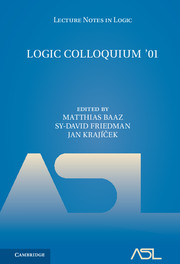Book contents
- Frontmatter
- Preface
- Contents
- TUTORIALS
- ARTICLES
- Modified bar recursion and classical dependent choice
- Choice and uniformity in weak applicative theories
- Compactness and incompactness phenomena in set theory
- Selection for Borel relations
- Interpolation in goal-directed proof systems 1
- Sequences of degrees associated with models of arithmetic
- The limit theory of generic polynomials
- Moschovakis's notion of meaning as applied to linguistics
- Tameness in expansions of the real field
- The model theory of compact complex spaces
- “Natural” representations and extensions of Gödel's second theorem 350
- Effective Hausdorff dimension
- Mutual stationarity in the coremodel
- The pair (Nn, N0) may fail N0-compactness
- Incompleteness theoremand its frontier
- Groups in Simple Theories
- References
The model theory of compact complex spaces
from ARTICLES
Published online by Cambridge University Press: 31 March 2017
- Frontmatter
- Preface
- Contents
- TUTORIALS
- ARTICLES
- Modified bar recursion and classical dependent choice
- Choice and uniformity in weak applicative theories
- Compactness and incompactness phenomena in set theory
- Selection for Borel relations
- Interpolation in goal-directed proof systems 1
- Sequences of degrees associated with models of arithmetic
- The limit theory of generic polynomials
- Moschovakis's notion of meaning as applied to linguistics
- Tameness in expansions of the real field
- The model theory of compact complex spaces
- “Natural” representations and extensions of Gödel's second theorem 350
- Effective Hausdorff dimension
- Mutual stationarity in the coremodel
- The pair (Nn, N0) may fail N0-compactness
- Incompleteness theoremand its frontier
- Groups in Simple Theories
- References
Summary
The usual model-theoretic approach to complex algebraic geometry is to view complex algebraic varieties as living definably in the structure (C,+,×). Variousmodel-theoretic properties of algebraically closed fields (such as quantifier elimination and strong minimality) are then used to obtain geometric information about the varieties. This approach extends to other geometric contexts by considering expansions of algebraically closed fields to which the methods of stability or simplicity apply. For example, differential algebraic varieties live in differentially closed fields, and difference algebraic varieties in algebraically closed fields equipped with a generic automorphism. Another approach would be to consider the variety as a structure in its own right, equipped with the algebraic (respectively differential or difference algebraic) subsets of its cartesian powers. This point of view is compatible with the theory of Zariski-type structures, developed by Hrushovski and Zilber (see [21] and [41]). While the two approaches are equivalent (i.e., bi-interpretable) in the case of complex algebraic varieties, the latter point of view extends to certain fragments of complex analytic geometry in a manner that does not seem accessible by the former.
Zilber showed in [41] that a compact complex analytic space with the structure induced by the analytic subsets of its cartesian powers is of finite Morley rank and admits quantifier elimination. Since then, there have been a number of papers investigating various aspects of the model theory of such structures, as well as possible applications to complex analytic geometry. The most notable achievement has been a kind of Chevalley Theorem due to Pillay and Scanlon [35] that classifies meromorphic groups in terms of complex tori and linear algebraic groups. It has become clear that compact complex spaces serve as a particularly rich setting in which many of the more advanced phenomena of stability theory are witnessed. For example, the full trichotomy for strongly minimal sets (trivial, not trivial but locally modular, and not locally modular) occurs in this category. It also seems reasonable to expect that a greater model-theoretic understanding of compact complex spaces can contribute to complex analytic geometry, particularly around issues concerning the bimeromorphic classification of Kähler-type spaces.
Information
- Type
- Chapter
- Information
- Logic Colloquium '01 , pp. 317 - 349Publisher: Cambridge University PressPrint publication year: 2005
References
Accessibility standard: Unknown
Why this information is here
This section outlines the accessibility features of this content - including support for screen readers, full keyboard navigation and high-contrast display options. This may not be relevant for you.Accessibility Information
- 1
- Cited by
